The Infiniti G-Series is undoubtedly one of the sleekest and sportiest sport car lines on the market. But they don’t just provide a pleasing aesthetic appeal — they’re performance monsters too.
While both the G35 and G37 are amazing cars, if you’re looking for a little help in choosing between the two models, we’ve got you covered.
In this guide, we’ll explore the brief history of the Infiniti G-Series before diving into the nitty-gritty differences between the two models. By the end of it, you’ll have everything you need to tell these two vehicles apart and choose the right one.
A Comprehensive History
The Infiniti G-Series was one of the most popular vehicles in the U.S. market ever since it stormed into the scene. It was one of those rare brands that didn’t rest on its laurels and continued to make improvements year after year.
But just as quickly as it arrived to make its mark, it soon vanished. The discontinuation of the G-Series only adds to its lore and rabid fanbase. Till today it remains one of the most popular cars on the market.
But how exactly did it come to be, and what are the differences through the limited model years? We’ll give you a quick tour here before diving into the differences between the G35 and the G37.
The Early Years
The Infiniti G-Series didn’t always have its signature “G” label. In fact, The Infiniti G-Series started as the “P-Series,” and Infiniti based the P-Series on the Nissan Primera. The modern G-Series really didn’t begin to take shape until 2002, when Infiniti changed the design completely to mimic the Nissan Skyline.
The entire G-Series is nothing more than a rebadged version of the Nissan Skyline. While the Skyline is highly popular among auto enthusiasts, you can’t import most models to the United States until they’re over 25-years old.
Oddly enough, while the Infiniti G35 made its way to the United States, the rest of the world had the same automobile, only it was known as the Nissan V35.
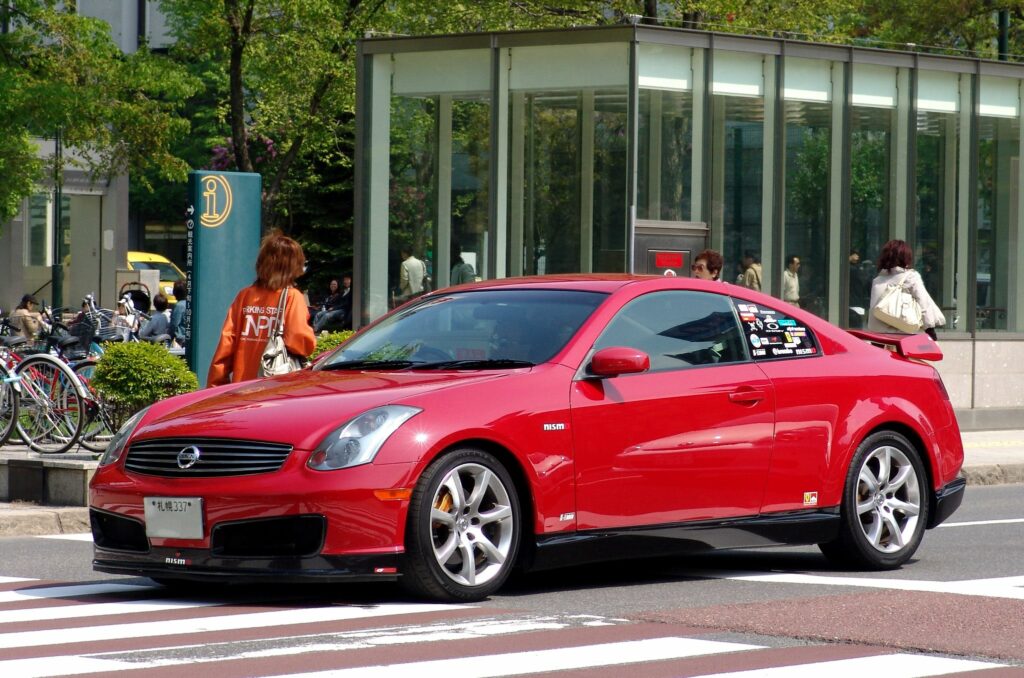
Without access to the Skyline in the United States, it didn’t take long for the G35 to gain popularity. In 2003, the G35 won the Motor Trend’s Car of the Year award and received wide-spread popularity throughout the country.
It wasn’t hard to see why. It boasted a powerful engine, multiple trim packages, and the ability to easily upgrade it to whatever you wanted.
The 2005 and 2006 Refresh
In 2005 and 2006, the Infiniti G-Series underwent its first significant refresh. For starters, Infiniti firmed up the frame with more welds and structural reinforcements throughout the engine bay and rear flooring area.
But it wasn’t just improvements to the chassis that Infiniti completed during the refresh. They also improved their sports package by including firmer rear shocks, larger brakes, and an upgraded limited-slip differential.
Moreover, they upgraded the engine and installed electrically actuated variable valve timing on the exhaust cams. It was a significant refresh that delivered big results. By 2007 they had shaved seven-tenths of a second off the 0-60 time.
The New Fourth Generation
In conjunction with the significant refresh, Infiniti completed their five-year development program on the G-Series in 2007. This five-year development program, kick-started in 2002, eventually leading to the creation of the G37.
The fourth-generation Infiniti series includes more than the G35 and G37 as it also includes their G25 and Q40 lines that were released in 2011 and 2015, respectively.
While the fourth generation of the G-Series officially kicked off in 2007, it ran all the way until 2015. During this time, Infiniti created a larger engine, an automatic transmission with more gears, and developed an innovative technology called Variable Valve Event and Lift (VVEL).
When they got all this together into a single-vehicle, they released their new line – the G37.

The Creation of the G37
The G37 didn’t exactly come out of nowhere. Infiniti released their fourth generation in 2007, but it wasn’t until they got all the parts they had been working on into a single vehicle that they released the G37.
They did this in 2008 for the G37 Sedan, but it took them an extra model year until they got everything together for the G37 Coupe they released in 2009.
The G37 Convertible
Possibly the most significant change to the G-Series line occurred in 2009. That’s when Infiniti added the G37 Convertible to the lineup. The G37 Convertible featured the same 3.7L V6 engine, but this one produced 325-horsepower due to a tuning difference.
The G37 Convertible comes with either a 7-speed automatic transmission or a 6-speed manual transmission. Overall, everything is identical to the Sedan and Coupe — except for the body style.

One Final Facelift
In 2009 Infiniti started and completed their last major facelift for their G-Series line. They had all the changes ready to go by 2010, and most of these changes were in cosmetic and comfort features.
They added a new grill for the Sedan, added an optional navigation system, and offered a few different interior colors.
The 2009 facelift wasn’t as significant as the one they completed on the G35 in 2005, but many G37 enthusiasts love the sportier look the 2009 facelift gave the car.
Adieu to the G-Series
In an odd twist, Infiniti discontinued their G-Series in 2013. For their final year of production, Infiniti labeled the G37 as the Q40 before they discontinued the entire line in 2015. While the Q40 didn’t bear the G-Series name, it was almost identical in every other way to the G37.
Before Infiniti discontinued the Q40, they released the Q60 in 2014. The Q60 has been their direct replacement. While the Q60 has enjoyed its own levels of success, many G-Series enthusiasts still reminisce about the G35 and G37, and much prefer these production lines.
G35 vs G37: Sedan and Coupe
When Infiniti released the G37 Sedan in 2009, the exterior and interior options remained identical to the G35. That means purely by a visual inspection, it’s almost impossible to tell the two models apart.
But as soon as you popped the hood, a whole new story emerged. Instead of the 3.5L V6 engine, they installed a 3.7L V6. All the new G37 models also came standard with a seven-speed transmission.

From there, they offered a wide array of different packages, which we’ll dive into section by section later.
In 2008, a year before Infiniti released the G37 Sedan, they launched the G37 Coupe. There were several changes to the G37, but the most significant was the new 3.7L V6 engine that came in every model.
Not only did they get a brand new engine, but it was the first time that Nissan used their Variable Valve Event and Lift (VVEL) system in any of their vehicles.
Key Differences Between the G35 and G37
While the G35 is the direct predecessor to the G37, that doesn’t mean that there aren’t a host of differences between them. In fact, Infiniti decided that they’d changed enough to warrant an entirely new badge for the vehicle.
After an in-depth look, we’re more than inclined to agree with them. These are two entirely different vehicles that offer their own host of perks and drawbacks.
Engine
Unlike many manufacturers that offer different engine packages for different trim levels, Infiniti offers only one engine package for both the G35 and the G37. In fact, it’s the different engines that prompted the change from the G35 to the G37.
The G35 utilizes a 3.5L V6 engine that produces 306-horsepower, while the G37 uses a slightly larger 3.7L engine that makes a whopping 330-horsepower.
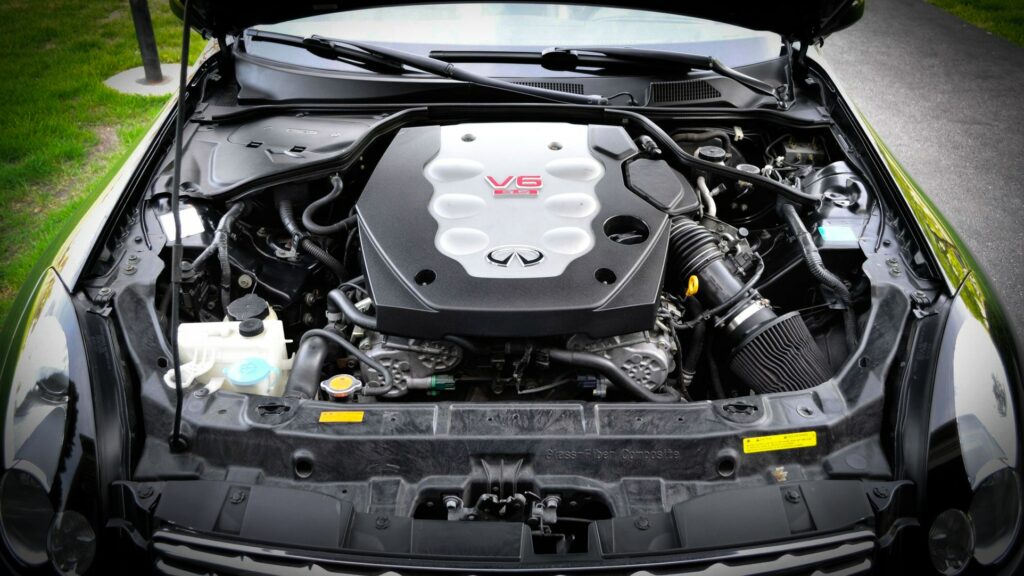
One of the key differences between the engines, besides their different sizes, is the Variable Valve Event and Lift (VVEL system). VVEL is a variable timing system that finetunes engine timing during various driving conditions.
The system itself is a little complicated, but it’s similar to BMW’s Valvetronic system and improves overall engine efficiency and increases the overall power output. It also helps the G37 meet different environmental standards since it produces less waste with each cycle.
Handling, Suspension, and Chassis Differences
Both the G35 and the G37 offer premium suspension packages with their vehicles. While both options come with adequate suspension systems for the job, they both offer upgraded sports suspension packages too.
The standard G35 suspension package comes with 17″ and 18″ rims and OEM linear springs. The upgraded sports package comes with 19″ rims and a rear suspension system that is about 25% stiffer. In fact, the 2008 G35 has the same suspension system as the G37 models.
Starting in 2007, Infiniti made significant revisions to the chassis of the G35, and these revisions carried over to the G37 when it made its debut in 2008.
These changes included adding extra weld spots throughout the frame, structural reinforcements around the engine, and tripling the overall laser welding. All of these changes combined to create a 40% stiffer ride on the refreshed G35, which you’ll notice if you jump from an early era G35 straight to a G37.
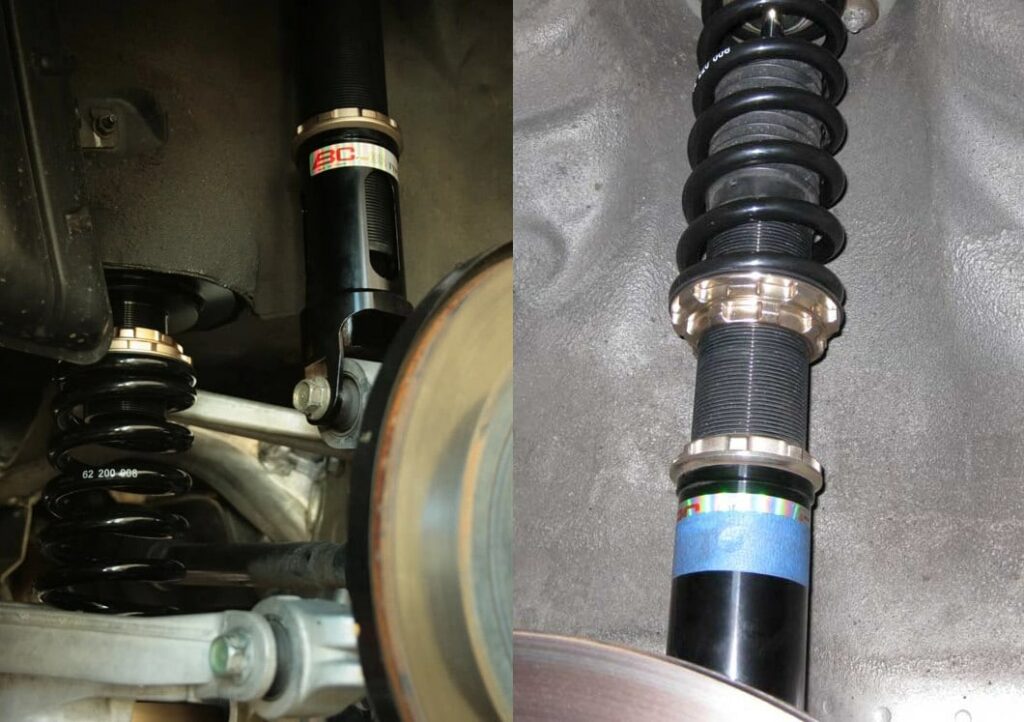
This is why you’ll often find many owners install aftermarket coilovers in their G35. It’s an affordable way to stiffen up the ride of their car without having to budget for a G37.
Finally, the G37 is a slightly heavier ride than the G35. A large part of this comes from the larger transmission and engine, but overall you can expect a G37 to weigh between 300 to 400-pounds more than a G35.
Overall, you’ll find that both the G35 and G37 have phenomenal handling, and you likely won’t run into any problems with performance.
Gearbox and Transmission
The differing gear ratios are among the first things drivers notice when jumping from a G35 to a G37 or vice versa. Infiniti installed much more aggressive gear ratios in the older G35s.
This led to many complaints from those who weren’t looking for a sports car but instead wanted something a little more comfortable. Infiniti listened with the G37 and scaled back the gear ratios a bit, especially at lower speeds.
This is why you might not feel like you’re going as fast in a G37 — even though you’re actually going faster than you would in a G35.
But Infiniti didn’t just change the gear ratios in their existing transmissions when they did this. Instead, they designed a new 7-speed automatic transmission which replaced the 5-speed automatic seen in the G35.
Interior and Exterior Aesthetic Differences
This is one of the areas that you’re going to struggle to find any differences. In fact, when comparing the 2009 G37 Sedan to the 2008 G35 Sedan, you’re not going to find many aesthetic differences.
Through the years, Infiniti did make some different aesthetic changes to the G37 model. For example, from 2009 to 2010, they made some changes to the front grille and fascia.
Moreover, they changed interior features throughout the years, like the center console and instrument panel. But you can’t pinpoint those changes to a difference between a G35 and G37 because, with the 2009 G37, those features are identical to the 2008 G35 as well.

With that being said, in 2009, Infiniti released the G37 Convertible. It came with everything that the Coupe or Sedan versions offered but instead had a convertible body style. The G35 never had this trim option.
Comfort Features
Like every other car out there, the newer the model, the more comfort features you’ll find. With the G35 and the G37, this isn’t any different. For example, the 2010 G37 comes with USB ports in the instrument panel, where this was never an option before with either the G35 or the G37.
Still, these aren’t necessarily differences between the G35 and the G37. Instead, they’re differences seen depending on the model year. These comfort features also vary by the trim package that you select. Base models offered fewer premium features like heated seats and upgraded stereo systems compared to higher trim levels.
Fuel Economy
If you’re looking for a difference in fuel efficiency, there’s not much to talk about. While it varies a little bit by model year and the package that you select, they’re almost identical overall. As an example, the 2006 Infiniti G35 offers 17 mpg city, 24 mpg highway, and a combined 20 mpg overall.
Meanwhile, the 2013 Infiniti G37 offers 17 mpg city, 25 mpg highway, and a combined 20 mpg overall. Like we said, these numbers do vary a bit by model year and transmission type, but it’s not enough of a difference to make a notable impact on your experience.
Reliability Comparisons
When comparing the Infiniti G37 to the G35, it’s not really a fair comparison. That’s because while they’re both reliable cars, a G37 can be close to ten years newer than a G35.
This means that a G37 is far more likely to have lower mileage and less wear and tear compared to a G35 which plays a big role when getting your G35 insured.
However, when you compare a G35 against other cars from the same era, it holds up exceptionally well. U.S. News gives both the G35 and the G37 4.5 stars for reliability.
So, if you’re wondering which car will last longer, it’s probably the G37, but that’s just because it’s newer.
G35 vs G37 — Which Is Faster?
Breaking down the performance differences between the G35 and the G37 is surprising. Because while the G35 feels more aggressive, it’s actually outperformed in every category by the G37.
While it isn’t surprising that a vehicle manufacturer improved their vehicle with the newer model, you’d swear that the G35 was moving quicker if you turned off the stopwatch. That’s despite the fact that the G37 has a 330 horsepower engine compared to the 306 horsepower that the G35 produces.
It’s got everything to do with the gear ratios in the drivetrain, and you’re especially likely to notice the difference during your initial acceleration at slower speeds. It’s also why the G35 holds up slightly better in the 0-60 times, then falls even further behind for the ¼-mile times.
The numbers don’t lie, and we broke them down for you below. Keep in mind that we only took the fastest setups from each year — from both the sedan and coupe trim packages.
If you’re just looking for a few key takeaways from the charts — these are it:
- The fastest G35 is the 2007 RWD Sedan with the 6-speed manual transmission
- The fastest G37 is the 2009 RWD Sedan with the 7-speed automatic transmission
- While every G37 has a ¼ mile time of 14 seconds or faster, only one G35 does
- While the 60 times are similar, the G37 models have a slight edge over almost every G35
Infiniti G35 0-60 and ¼ Mile Times
| Year | Drive Type | Body Type | Transmission | 0-60 Time | ¼ Mile Time |
|---|---|---|---|---|---|
| 2002 | RWD | Sedan | 5-speed automatic | 7.1 seconds | 15.6 seconds |
| 2003 | RWD | Sedan | 6-speed manual | 5.78 seconds | 14.28 seconds |
| 2003 | RWD | Coupe | 6-speed manual | 5.7 seconds | 14.2 seconds |
| 2004 | RWD | Sedan | 6-speed manual | 5.9 seconds | 14.2 seconds |
| 2005 | RWD | Sedan | 6-speed manual | 5.8 seconds | 14.1 seconds |
| 2006 | AWD | Sedan | 5-speed automatic | 5.9 seconds | 14.4 seconds |
| 2007 | RWD | Sedan | 6-speed manual | 5.2 seconds | 13.9 seconds |
| 2008 | RWD | Sedan | 6-speed manual | 5.5 seconds | 14.1 seconds |
Infiniti G37 0-60 and ¼ Mile Times
| Year | Drive Type | Body Type | Transmission | 0-60 Time | ¼ Mile Time |
|---|---|---|---|---|---|
| 2008 | RWD | Coupe | 6-speed manual | 5.3 seconds | 13.9 seconds |
| 2009 | RWD | Sedan | 7-speed automatic | 5.0 seconds | 13.5 seconds |
| 2009 | AWD | Coupe | 7-speed automatic | 5.2 seconds | 13.7 seconds |
| 2009 | RWD | Convertible | 7-speed automatic | 5.5 seconds | 14.0 seconds |
| 2010 | RWD | Sedan | 7-speed automatic | 5.1 seconds | 13.6 seconds |
| 2010 | RWD | Coupe | 6-speed manual | 5.4 seconds | 13.9 seconds |
| 2011 | RWD | Coupe | 6-speed manual | 5.4 seconds | 13.9 seconds |
Which Is the Better Daily Driver?
If you’re looking for a daily driver, then the G37 is definitely the way to go. For starters, the less aggressive gear ratio is far more appealing to those looking for something to take them from point A to point B.
Furthermore, since the G37 models are newer, they’re likely to have more comfort features you’ll want for a daily driver. These amenities include USB ports, Bluetooth capabilities, and backup cameras.
Which One is Easier to Modify?
Since both cars utilize similar suspension and frame components, modifying a G37 or a G35 won’t be too difficult. Whether you’re looking for upgraded suspension components, engine modifications, or rims, there are tons of different things you can do to your Infiniti G35 or G37.
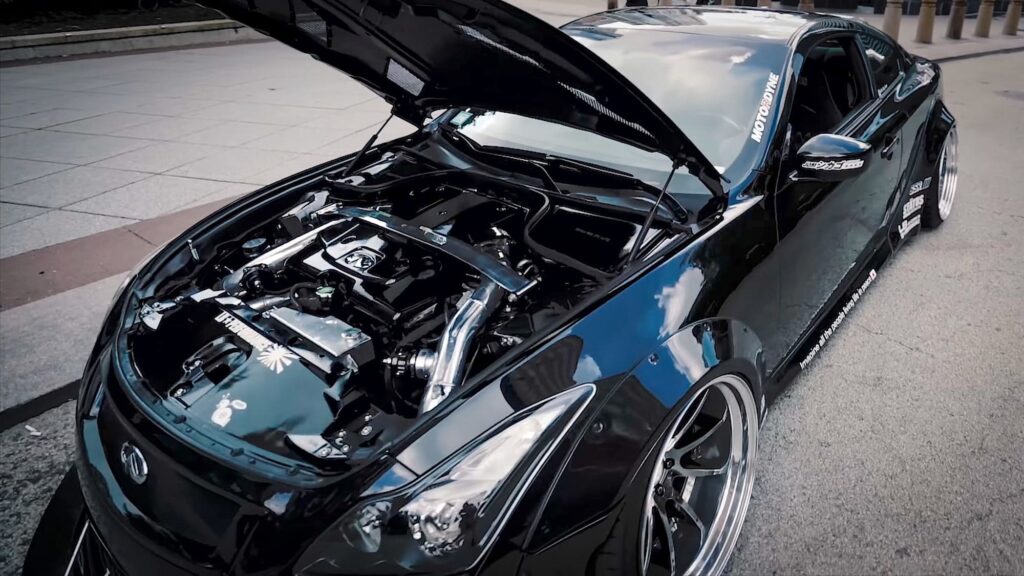
When comparing the cost to perform modifications, it’s relatively similar too. They utilize many of the same components, so if you’re looking for upgrades, many of the parts that will work on a G35 will work on a G37 too!
Infiniti G35 vs G37: Which One Should You Get?
You need to answer a few questions when you’re considering buying a G37 or a G35. To begin with, there’s the price difference. Because G35s are a little older, they tend to be cheaper than a G37. If you’re looking to buy a car, the price is a significant factor.
From there, it comes down to this question — are you more interested in how a car feels or how it performs? If you want a car that feels raw and powerful, you want a G35. The more aggressive gear ratios give you a more primal experience.
But if you’re looking for the faster of the two, the G37 is the way to go. Just know that if someone takes the time to modify their G35, they can still smoke you right off the track.
Ultimately, there’s no right or wrong answer to whether the G35 or the G37 is better — both made it to our list of the best tuner cars. It all comes down to your budget, preferences and driving style. You just have to decide what you want and go from there!
Do you have any more questions about either the Infiniti G35 or G37? Drop a comment below or check out some of the other guides!

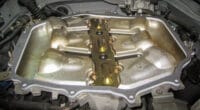
11 comments
Great review! Only question is, how much is overall performance affected when you add the convertible model? I assume the hard top convertible top must add considerable weight, plus, why is the convertible G37 5 horsepower less than the other models?
Thanks for any additional info.
Sincerely,
I’m looking to purchase a G37 very soon as my test drive of a 2009 model left me impressed to a point I didn’t know I could by a 6cyl car. What exactly is a “tuner car”, how much is it, and will it smog? Does it take a toll on the car? Thanks.
A ‘tuner’ car is a car that has been modified with aftermarket parts to its engine to improve performance. It usually will increase the wear on the car, especially since people who make those modifications drive the car harder (otherwise there was no purpose in making it more powerful). There is no set price, it depends on what modifications were made.
Great review! I own a 2008 G35XS and love it because it’s just so fun to drive. But dang, that firm suspension isn’t much fun for daily driving.
Thank you for this article! I’ve been stressing over which model Infiniti G series to buy. Unfortunately my budget will likely push me towards buying the G35x or G35. The G37 is just too expensive. I let a 2007 G35x with 145k on odometer perfect condition, 19″rims dark blue. $5,200 or best offer.! Crazy. Sold 10 min before I arrived!
G37 if they had it with manual 6 or 7.
Automatic transmission gives me nightmares, torque converter, slipping I jack it up and have no clue trouble shoot it or fix it..
Manual- piece of cake. Undo bell housing, pull out making sure not gouge your spline, pilot bearing? A real pain, but it’ll come out eventually, some skip this but I never do. Clutch, pressure plate, flywheel, t/o bearing , clutch fork etc…
Piece of cake…
ALWAYS REMEMBER TO DRAIN TRANSMISSION BEFORE PULLING THOSE BELL HOUSING BOLTS OR ELSE YOULL LEAVE YOUR GARAGE SMELLING TERRIBLE FOR YEARS…
2012 G37xS Coupe owner here: one thing to keep in mind with the G37 is that the gallery gasket in the engine is a known trouble spot (which is hard to get too and expensive to fix). It wasn’t until the 2012 and newer models that they replaced the paper gasket with a metal one from the factory. All the G37 cars (and maybe the G35) also have an issue with the water drain tubes that exit to the front of the car getting clogged and leaking inside footwell during a heavy rain. It’s a cheap fix and somewhat easy (lots of vids online) but annoying because of the tight space to work in.
The convertibles are the worse cars to get for performance. They are the heaviest (due to reinforcements to make up for the lack of a structural roof), have their engine power slightly reduced, and do not come in an AWD variant. The coupe is actually slightly heavier then the sedan but still out-performs it (very slightly).
The G35’s are known to burn oil and many add a simple and cheap modification of adding an oil catch can to the engine to help reduce that.
If you are considering a G37, only go for a 2012 or 2013 (it became the Q40 in 2014). That is the pinnacle of the car with everything fixed and is when Bluetooth for phone calls AND music was added to the car.
I have a 2005 G35 6 spd manual sedan and just picked up a 2008 G37s 6 spd manual coupe. Stay FAR away from any 2005 G35. The ’05 engines all burn oil badly. Mine is up to a quart every 2 weeks, if not more and starting to blow a little smoke if I lay on the throttle. 120K miles. Fuel gauge malfunction is a well known issue and can be either the tank senders or the gage cluster. I believe they fixed the engine issues in newer G35’s. I just can’t bear to get rid of the G35 (sentimental), so I’ll keep it for now. BTW, nobody sells crate engines for the 35, and finding someone to rebuild it is nearly impossible. I absolutely LOVE my G37s. Can’t go wrong.
change the valve cover and issue solved! valve covers need replacement even q50.
I have an 03 G35 with 147k miles on it. Have been using it as my daily driver for the past 5 years and love it. Will definitely get another one when I part ways with the one I have now. Bought it for 5.3k with 70k miles on it. Super reliable and a fun car to drive too!
Need help! First time Infiniti buyer looking ???? for advice. I’m stuck between an 06 g35 coupe and a 08 g37 sport 06. The G35 has less miles (121,000) and is more expensive while the G37 is cheaper but has more miles (171,000). Which is my best option?